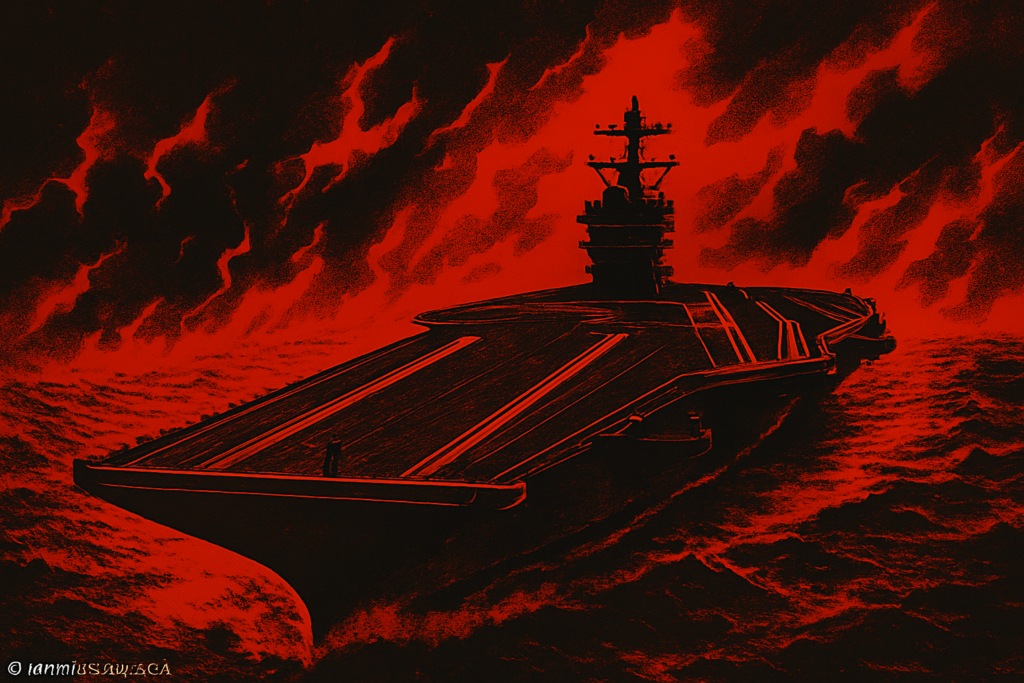The U.S. Military’s Expanding Maritime Campaign in the Caribbean and Eastern Pacific
Operation Southern Spear has rapidly become one of the most consequential U.S. military campaigns in the Western Hemisphere in decades — a hybrid counter-narcotics, counter-terrorism, and geopolitical pressure operation that is reshaping the maritime security environment from the Caribbean to the Pacific.
Launched under the Trump administration’s intensified “narcoterrorism” doctrine, Southern Spear brings together a carrier strike group, unmanned surface vessels, reconnaissance platforms, special operations forces, and an expanded Coast Guard/Navy interdiction network.
Although publicly framed as a counter-drug mission, the structure, scale, and political language surrounding the operation indicate a much broader strategic purpose.
This is the current snapshot.
The Strategic Trigger: Venezuela and the “Narcoterrorism” Label
A major catalyst behind Southern Spear was the administration’s move to formally designate the alleged Venezuelan network “Cartel de los Soles” as a Foreign Terrorist Organization (FTO).
This designation — unprecedented for a state-linked group in the Western Hemisphere — directly implicates associates of Venezuelan President Nicolás Maduro, whom U.S. officials accuse of enabling drug routes into North America.
The Guardian summarized the shift:
“The US will label the alleged Venezuelan drug cartel ‘headed by Maduro’ as a terrorist organization.” – The Guardian, Nov. 17, 2025
The FTO label unlocks authorities normally reserved for counter-terrorism, including broader kinetic action, expanded intelligence collection, and the ability to target associated actors outside traditional warzones.
Southern Spear is the maritime arm of that policy.
The Operational Footprint: Carrier Groups to Robotic Fleets
1. The USS Gerald R. Ford Deployment
In early November, the USS Gerald R. Ford, America’s most advanced aircraft carrier, was ordered into the Caribbean Sea along with its strike group.
NPR emphasized the historical significance of deploying a vessel of this scale into a hemispheric interdiction posture:
“The Ford, the most advanced carrier in the U.S. fleet, represents the Navy’s projection of overwhelming power.” -NPR, Nov. 16, 2025
The deployment signals an elevated threat environment — carriers are rarely used for routine interdiction.
2. Unmanned surface vessels (USVs) and autonomous systems
Months before the Ford’s arrival, the Navy had already begun standing up a mixed fleet of unmanned systems under the Southern Spear banner.
These vessels conduct:
- persistent maritime domain awareness
- remote interception
- high-risk close approaches
- surveillance of suspected narcotics routes
This is the most aggressive operational integration of USVs in U.S. naval history in the Western Hemisphere.
Strikes and Escalation: Lethal Engagements at Sea
Southern Spear is not a surveillance-only operation.
It includes direct kinetic engagements.
Reuters reported multiple strikes on suspected drug-smuggling vessels in the Pacific:
“The Pentagon says it struck another suspected drug boat in the Pacific, killing three.” /Reuters, Nov. 16, 2025
Euronews and additional outlets estimate the cumulative death toll of maritime strikes since September at more than 80 individuals, though numbers vary by report.
These engagements raise legal and diplomatic questions about:
- rules of engagement
- targeting standards
- transparency about intelligence
- proportionality under international maritime law
Human-rights organizations warn that opaque targeting risks eroding long-standing norms governing the use of lethal force in international waters.
Official Framing: Homeland Defense Through Maritime Interdiction
Publicly, U.S. officials describe Southern Spear as a hemispheric firewall against narcotics networks that contribute directly to U.S. overdose deaths.
Defense officials emphasize that Latin American maritime routes — particularly those linked to Venezuelan, Colombian, and transnational actors — have become essential conduits for synthetic drugs entering North American markets.
The administration’s messaging frames the operation as defensive:
“This mission defends our homeland from narcoterrorists.” -DoD statement summarized in AS USA, Nov. 2025
This language represents a sharp shift from prior decades, during which maritime interdiction was treated as law enforcement assistance, not counter-terrorism.
The Geopolitical Layer: Pressure on Maduro and Regional Response
While the U.S. insists the mission is aimed at drug networks, regional analysts note that the scale of force — including a supercarrier — aligns with geopolitical aims:
- isolating Venezuela
- degrading state-linked criminal networks
- increasing costs for maritime smuggling
- signaling to external powers (Russia, Iran, China) with a growing presence in the region
Regional governments are divided.
Some warn of U.S. overreach, while others welcome heavier interdiction pressure.
Venezuela has condemned the operation as:
- a violation of sovereignty
- a pretext for regime targeting
- an escalation that “endangers regional stability”
These claims reflect the broader geopolitical contest surrounding Venezuela’s alliances and the narcotics-geopolitics overlap.
Risks and Potential Blowback
1. Legal and moral hazard
With lethal engagements being conducted under a counter-narcoterrorism framework rather than traditional law enforcement models, concerns include:
- inadequate oversight
- risks of misidentification
- potential civilian casualties
- legal ambiguity regarding “combatant” status for smugglers
2. Diplomatic strain
Caribbean and Latin American nations are sensitive to U.S. maritime operations, especially when force is applied near territorial waters.
3. Mission creep
Analysts warn that an operation designed around drug interdiction could easily expand into:
- strikes on land targets
- expanded FTO enforcement
- direct confrontation with state-linked actors inside Venezuela
CSIS analysts have flagged the potential for escalation beyond maritime objectives.
4. Unintended regional militarization
Large deployments risk pushing regional governments toward external partners (Russia, China, Iran) for balancing support.
The Bottom Line
Operation Southern Spear marks a historic shift in U.S. hemispheric policy:
- Counter-drug engagement is now blended with counter-terrorism authority.
- Carrier strike power has returned to the Caribbean in force.
- Unmanned naval systems have entered frontline interdiction.
- The U.S. is signaling that maritime narcotics flows are now considered national-security threats.
If successful, the operation could disrupt key drug-smuggling routes and weaken state-linked criminal networks.
If mismanaged, it risks diplomatic fallout, legal challenges, and potential escalation with Venezuelan forces or their partners.
Either way, Southern Spear represents a defining turn in U.S. policy toward Latin America — one that merges anti-drug posture, counter-terrorism authority, and great-power signaling into a single, high-visibility maritime campaign.
Citations
- NPR – “USS Gerald R. Ford: History and Context” (Nov 16, 2025)
- The Guardian – “US to Label Alleged Venezuelan Drug Cartel ‘Headed by Maduro’ as Terrorist Organization” (Nov 17, 2025)
- Reuters – “Pentagon Says It Struck Another Suspected Drug Boat in Pacific, Killing Three” (Nov 16, 2025)
- AS USA / Diario AS – “Estados Unidos Anuncia Operativo Para Combatir el Narcoterrorismo” (Nov 2025)
- Euronews – “US Confirms Deadly Attack in the Caribbean Under Southern Spear; 80 Dead” (Nov 15, 2025)

